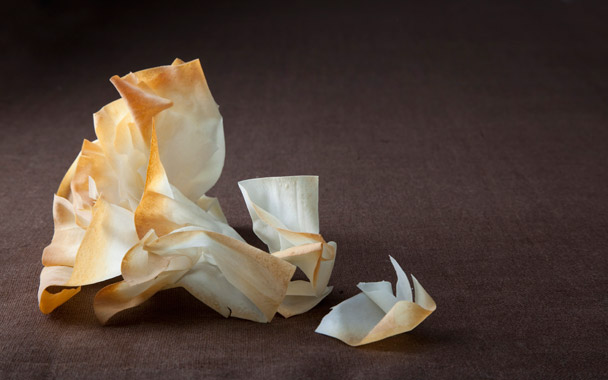Every time my wife, Tara, comes home from her trips to Greece, she’s pumped about phyllo pies. This time, she went to the north, which prides itself on its vast array of pies. “Everyone makes their own version,” she said. “Spanakopita is just the beginning. The ones called hortopita are made with wild greens—weeds, really—and Thessaloniki is famous for bougatsa, a sweet pie filled with custard. I had an incredible Lenten pie this week made from greens and chopped hazelnuts. I’m going to make you one.”
My wife is brave, I thought at the time. I remember the first day I worked in a restaurant kitchen. I was helping my friend Jordan prep for lunch service, and he was showing me how he wanted me to wrap up some fish, mushrooms, and ramps in phyllo. He painted the prep table with melted butter, laid down a sheet of phyllo, painted that with melted butter, and repeated until he had a pile of five or six sheets. “Work quickly but confidently,” he told me. “Phyllo can smell your fear.” I ruined my first two packets (one cracked, and one was butter-logged), then brought him my third. “That’s great, that’s great.” He gave me a big smile. “Now can you make them, like, five times faster?”
The pies Tara loves turn out to be easier to make for two reasons: One, she prefers the slightly thicker “country-style” phyllo, which she says is what the good savory pies are made from in the north, and two, the pies are made in big layers, so there’s no tempting the phyllo-tearing gods with the fiddly construction of individual packets. Since nothing green is growing within 200 miles of New York these days, Tara improvised some bitter greens from a mixture of chard, arugula, scallions, and an enormous amount of parsley. She cooked some leeks in a wide pan, then added the huge pile of greens and cooked it for a few minutes until it reduced a lot in volume. She drained the greens and mixed them with a big chunk of crumbled, salty Greek feta cheese, a few beaten eggs, and some fine-chopped capers. Then she took a cake pan, coated it liberally with melted butter, draped a phyllo sheet in the pan, and repeated for four or five sheets, until the cake pan looked like a phyllo flower. She plopped half the greens into the center, layered them with a couple sheets of phyllo, then added the rest of the greens and folded the phyllo over the top. The pie went into the oven for an hour to cook through and brown on top.
The whole point of phyllo, of course, is to add terrific crunch and a touch of delicacy to the thing inside (and to make it more finger-food-friendly). This turns out to work really well with a greens/cheese mixture, which brings together bitter, salty, and creamy. Tara served the pie with some little onions she’d braised with saffron and honey using a recipe out of The Real Greek at Home. We ate it for dinner after the clocks had changed. The toddler had gone to bed willingly. There was light in the sky and a hint of the warm weather to come. I eyed the phyllo and started thinking of things to make, now that the code had been broken.




 Pinterest
Pinterest


